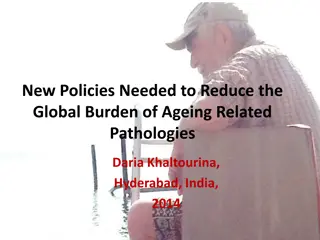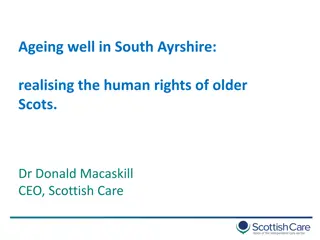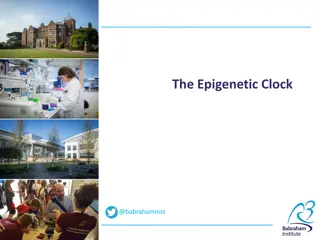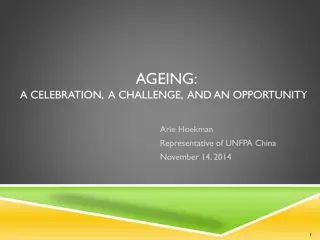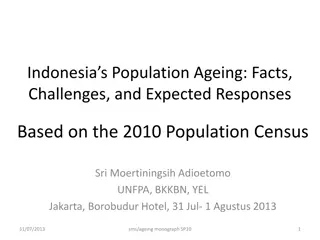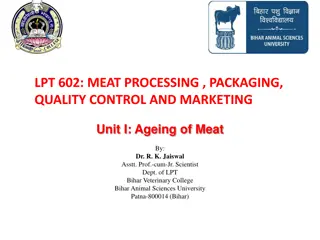Addressing Housing Challenges for Scotland's Ageing Population
Scotland's ageing population presents challenges and opportunities for the housing sector. The construction industry is innovating with solutions like off-site manufacturing and digital construction to meet changing demands. Creating age-friendly homes is crucial for a healthier, independent lifestyle in older age. With a focus on adapting existing housing stock and building new suitable homes, stakeholders in Scotland aim to support active ageing and meet the evolving needs of older residents while also tapping into the growing spending power of the 60+ age group.
- Ageing Population
- Housing Challenges
- Age-Friendly Homes
- Construction Innovation
- Stakeholder Engagement
Download Presentation

Please find below an Image/Link to download the presentation.
The content on the website is provided AS IS for your information and personal use only. It may not be sold, licensed, or shared on other websites without obtaining consent from the author. Download presentation by click this link. If you encounter any issues during the download, it is possible that the publisher has removed the file from their server.
E N D
Presentation Transcript
AGE FRIENDLY PLACES EVIDENCE PACK 1 1
Potential ways to meet changing demand for housing could include: Ensuring that existing housing stock is appropriate and adaptable Building new suitable homes: both specialised and mainstream Helping people to move to a home that is appropriate for them Executive Summary Scotland s population is ageing in line with UK, European and global trends. Currently 0.97 million people in Scotland are aged 65+ (1 in 6 of the population). By 2041, this is projected to rise to 1.47 million (1 in 4). However there are challenges with each of these. The construction sector is investing in a range of innovative home building solutions to address these challenges and meet the changing demand, including: Off site manufacturing to increase the speed and efficiency of housebuilding and improve productivity. More use of automation and digital construction, often referred to as BIM (Building Information Modelling) which could enable older residents to customise their new build homes direct to the factory The emergence of the Build-to-Rent (BTR) business model in the UK market, including affordable BTR which could perhaps be applied to creating affordable age friendly apartments as part of the overall mix of private rental sector options in Scotland. This changing demographic will bring challenges and opportunities. One of the biggest challenges will be how to support more older people to remain active and productive and enjoy longer, healthy independent lifestyles. Creating age friendly places across urban and rural Scotland could help address this challenge if it can be done at sufficient scale to meet growing future demand. Age Friendly Housing Suitable, good quality housing can significantly improve life in older age, while unsuitable housing can be the source of multiple problems and costs. Poor quality housing across the UK costs the NHS an estimated 2.5bn per year. Well designed homes that can adapt to people s changing needs as they age have a number of benefits: including reducing demand on emergency health and care services and enabling individuals to work more flexibly in later life. Overall there is a lack of inspiring good practice to demonstrate what age friendly homes could look like in a mainstream context and hardly any examples of the multi-sector collaborations that will be essential to deliver the integrated mix of products and services to create the type of age friendly place that will support longer, healthy independent living. The vast majority (90%) of older people in Scotland live in mainstream housing in their existing communities and want to remain there. Therefore an integrated, holistic approach that adapts homes and neighbourhoods to make them more age-friendly, combining supportive technologies and innovations in the delivery of health and social care services at home, could support healthy, active ageing. Increased wealth and spending power Whilst there is real diversity of incomes, wealth and spending power amongst older people, overall the 60+ age group is accumulating wealth and has increasing spending power. Home ownership in this group is high. For example, in Scotland s 60+ age group, 64% own their homes outright and have no mortgage debt. Scotland s 2.5 million housing stock is 58% owner-occupied and 38% rented. The rented sector is split fairly evenly between private rental (15%), local authorities (12%) and housing associations (11%). The Scottish Government has set a target to build 10,000 affordable new homes per annum. Older people will make up a steadily growing share of consumer markets over the coming decades, creating new commercial opportunities for targeted products and services across a range of sectors including home improvements, construction, digital technologies, tourism, healthcare, financial services and food & drink, across Scottish, UK and global markets. Hence there is a range of stakeholders with an interest in how the housing sector in Scotland needs to adapt to meet the changing demands of an ageing population, from individual homeowners and private landlords, builders and developers, through to local and national governments. 2 2
Longer working lives Where is the market in Age Friendly Places ? As the population ages, so will the UK workforce. The productivity and economic success of the UK will increasingly be tied to that of older workers. Enabling people to work for longer will help society to support growing numbers of dependents, while providing individuals with the financial and mental resources needed for increasingly long retirements. Working lives are already getting longer with older workers making an increasingly important economic contribution as well as enjoying the non-financial benefits of increased resilience and improved health and wellbeing attributed to working longer. However there are variations across the UK and Scotland has one of the lowest rates of men aged 65+ in employment. In all UK regions, the employment for men in this age group is higher than women. These variations raise concerns about the extent to which the whole UK can achieve the benefits of longer working lives. On the demand side, the customers for the innovations that support greater independent living will be a combination of individual homeowners and/or their families purchasing products and services for themselves, private and social landlords adapting houses for their ageing tenants and private and public care providers looking for significant efficiencies and productivity gains to meet growing demand for their services. So far, however this market has not manifested. It is a fragmented and nascent market that needs to be developed and structured. There is a low level of understanding of the products and services available, poor market uptake and a degree of expectation that this should be provided by the state via councils and the NHS. There is limited buy-in from customers and limited public investment Healthy ageing Maintaining good health is a major factor in enabling longer, active, productive and independent living. However in Scotland longevity is not currently being matched by healthy ageing. More people are having to manage multiple long-term health conditions as they grow older, such as chronic obstructive pulmonary disease (COPD), heart failure, diabetes and hypertension. If this trend continues it will result in a long-term increase in demand for Scotland s health and social care services, resulting in significant pressure on the health budget. Age Friendly Place Demonstrator There is a need to develop demonstrator sites in urban and rural Scotland to test and validate new products and services and show how these can be integrated in home settings. These demonstrator facilities need to operate at scale in real homes where older residents can adopt newly developed products and services allowing them to maintain their lifestyle and independence. In Scotland, around one-third of people over 65 years and living in the community fall at least once a year. The annual cost to health and social care service in Scotland of managing the consequences of falls is in excess of 470m (2013 figure). The demonstrator should allow the development of new business models to show how cross-sector and cross-agency collaborations (service providers) can work in partnership with the consumer to deliver a novel approach to the delivery of flexible, adaptable state of the art accommodation regardless of the specific location Emergency hospital admissions and hospital care make up 50% of the total 4.5bn NHS and council spend on older people s care in Scotland (2011/12 figures). Therefore there is a significant cost driver to develop innovations in the delivery of health and social care services to older people at home or in their communities. This will demonstrate how this market could be developed in Scotland and how products and services that work in the Scottish market could be adapted and sold in global markets. 3 3
Definitions Introduction Age friendly homes now, and in the future, should be attractive and have four main functionalities. These increase in their complexity (1 to 4) and their reliance on the integration of service providers and digital technologies in the home. They also present an increasingly futuristic vision. These could be achieved through adaptations to existing homes or through the construction of new ones. What do we mean by age-friendly places ? The Age UK definition of age friendly places1 are communities where the environment, activities and services support and enable older people to: Have opportunities to enjoy life and feel well Participate in society and be valued for their contribution Have enough money to live well Feel safe, comfortable and secure at home Access quality health and care 1. Accessible and functional: The home should be accessible and functional for all people, regardless of any impairments. There is already a great deal of well established design guidance available for new building works and retrofits to existing homes for older people. Much of this is achievable now through physical adaptations such as removing barriers, levelling floors, adding aids such as handrails and options to enable greater mobility around the house. 2. Measure, monitor and evaluate health and wellbeing. Using digital technologies for health monitoring, the home could have the ability to measure heart rate, blood pressure, nutritional intake etc to collect data and make initial assessments on the resident s wellbeing. 3. Take action: This data may enable the home to take action, such as sending an alert to prompt the resident to take medication or exercise, or raising an alarm to a carer, healthcare provider or emergency services on the risk, for example, of falls. 4. Offer facilities: The home could provide services such as entertainment and online shopping as well as mechanised home support for meal preparation or to make direct appointments with a healthcare visitor, sports club, social networks etc The World Health Organisation has led the way in building a network of Age Friendly Cities2 across the world who are committed to creating physical and social environments that promote health and a good quality of life for residents in older age. They encourage active ageing and have produced a guide to creating the age-friendly city, which identifies eight key issues to address: housing; community support and health services; outdoor spaces and buildings; transport; communication and information; respect and social inclusion; social participation and; civic participation and employment. Age friendly homes Housing is the main focus of this research report. The vast majority (90%) of older people in Scotland live in mainstream housing in their existing communities and want to remain there. Therefore an integrated, holistic approach that adapts homes and neighbourhoods to make them more age-friendly, combining supportive technologies and innovations in the delivery of health and social care services at home, could play a significant role in supporting active ageing and longer, healthy independent living in Scotland. In addition, an age friendly home should sit in an environment that enables contact with others in the neighbourhood, easy access to local shops, restaurants and leisure facilities and good connections to accessible public transport. The EU-funded project Neighbourhoods of the future presents useful definitions of age friendly homes and neighbourhoods and sets out the challenges in creating age friendly places at scale.3 This wider concept of place is important to ensure that older people can participate as freely and easily as possible in their communities and avoid becoming socially isolated or lonely. 4 4
Challenges to doing this at scale Important features of a demonstrator There are five key challenges to building age friendly places at sufficient scale to meet future growing demand: It is of course important that any exemplar model can help address these five key challenges to doing this at scale and demonstrate how creating age friendly places can move beyond experimental and pilot programmes to become mainstream. 1. This is a nascent, fragmented and complex market that needs to be developed and structured. On the demand side there are a range of potential customers such as individual homeowners, private landlords, housing associations and councils. In future they may be looking for a range of solutions increasing in complexity from physical adaptations to the house through to integrated service provision enabled by innovative digital technologies. However at this stage there is limited buy-in from customers and little public investment. On the supply side there may be a need for suitable standards that allow interoperability across technologies. Therefore some important features will be: The engagement of key stakeholders such as Scottish Government, local authorities, housing associations, public & private landlords, developers, construction firms, NHS Scotland, technology companies etc. A model that enables the design and build of flexible and adaptable accommodation as well as the retrofitting of existing homes and care facilities. The ability to demonstrate solutions for urban and rural homes The opportunity to develop and evaluate a variety of flexible occupancy models: owner occupiers; tenants; serviced occupancy agreements & build-to-rent facilities; timeshare etc. A real living and working environment where the very latest technologies and practices can be installed and evaluated This could suggest a hub and spoke model The hub might be a centrally located (urban?) facility working in collaboration with industry, research (universities), colleges, NHS Scotland, Innovation Centres and technology providers. The spokes could be public and private stakeholders living in or providing accommodation in more remote locations (rural villages?) across a range of settings where older residents can adopt newly developed products and services allowing them to maintain their lifestyle and independence. The demonstrator should allow the development of new business models to show how cross-sector and cross-agency collaborations (service providers) can work in partnership with the consumer to deliver a novel approach to the delivery of flexible, adaptable state of the art accommodation regardless of the specific location. 2. There is a lack of awareness amongst all the relevant stakeholders about the products and services available in this market and in particular a lack of knowledge on the costs involved. 3. There is also a lack of inspiring good practice to demonstrate what age friendly places could look like in a mainstream context. There are some examples which demonstrate how accessible and functional age friendly homes can be designed, constructed or adapted but hardly any demonstration of the more complex, innovative applications of digital technologies in this market for application in mainstream housing. 4. There are hardly any examples of the multi-sector or multi-agency collaborations that will be essential to deliver the integrated mix of products and services to create the type of age friendly place that will support longer, healthy independent living. 5. There are no clear business models to follow that set out how collaborations would work in practice and how the various partners would secure a return on investment in developing age friendly places. This would need to work at scale to enable mass production that could meet future growing demand ( IKEA model ) and that all stakeholders would recognise as a viable model. 5 5
Global demographics: the world is ageing4 The UK s population is ageing5 The gradual increases in UK life expectancy and average age experienced during the 20th century are projected to continue. Populations around the world are ageing rapidly as birth rates decline and life expectancy increases. Between 2000 and 2050, the proportion of the world s population aged 60 years or over will double from about 11% to 22%. The absolute number of people aged 60 years or over is projected to increase from 900 million in 2015 to 2,100 million by 2050. More than 70% of UK population growth between 2014 and 2039 will be in the over 60 age group; an increase from 14.9 million to 21.9 million people (see Figure 1) This ageing effect is most pronounced in wealthier, developed regions where these two factors fewer children and longer lives combine most dramatically. Figure 1: UK population projections by age, based on ONS data 2014 By 2050: Europe will have about 34% of its population aged 60 or over Latin America and Asia will have about 25% Although Africa has the youngest population structure of any major area, it will see the number of people aged 60 years or over increase to 147 million (from 46 million in 2015) Countries such as Japan, Greece, Italy, Spain and Austria will have more than two in five people aged 60 or more. 33 countries are expected to have more than ten million people aged 65 years or more, including five countries with more than 50 million older people in this age group: China (437 million), India (324 million), USA (107 million), Indonesia (70 million) and Brazil (58 million). The over 80 age group is expected to more than triple in size, rising to 4.5% of the global population. 6
The projected ageing of the population can also be shown by breaking down the changes by age group as shown in Figure 3. Scotland s population is ageing6 Over the next 10 years, there is projected to be a decline in population in the 16-24 age group (9% decrease) and the 45-64 age group (4% decrease). There are modest increases of 2% and 5% for people aged 0- 15 and 25-44 respectively. However, the largest percentage increases in population are projected for the oldest age groups, 65-74 (13% increase) and 75 and over (27% increase) Scotland s population is projected to rise from 5.40 million in 2016 to 5.69 million in 2041. It is also ageing in line with the general UK, European and global trends. Currently 0.97 million people in Scotland are aged 65 and over (1 in 6 of the population). By 2041, this is projected to rise to 1.47 million (1 in 4 of the population). Over the next 25 years, the ageing population is projected to become even more pronounced. There is a larger increase projected for the 65- 74 age group (17% increase) and the 75 and over age group, which is projected to increase by 79%. All of the other age groups below age 65 are projected to decline in population over the next 25 years to 2041. A population pyramid is a good way of illustrating the age and sex structure of the population. Figure 2 represents the population of Scotland in 2016 and projected for 2041. Each bar in the pyramid represents a single year of age and the length of the bar relates to the number of people of that age in the population. The solid bars represent the population for 2016 and the lines represent the projected population in 2041. In addition to the general ageing trend, this figure also shows a particular effect on the projected age structure of Scotland s population as the baby boomers of the 1960 s age over the next 25 years. This large group, around age 50 in 2016 become age 75 by 2041. Figure 3: The projected percentage change in Scotland s population by age group, 2016-2026 and 2016- 2041 Figure 2: The projected age structure of Scotland s population, 2016 and 2041 7 7
Housing is a devolved matter. Scotland s housing market 7,8 The Scottish Government, councils, housing associations and the private sector, including the construction sector, all have an important role to play in housing in Scotland. The composition of Scotland s 2.5 million housing stock (2016) is shown in the table below. 58% are owner occupied and 38% rented. The rented sector is split fairly evenly between private rental (15%), local authorities (12%) and housing associations (11%) Around 77% of homes in Scotland are in the private sector, either through home-ownership or as private rentals. The other 23% of homes are in the public sector and are rented through councils or housing associations. 58% Owner Occupied (1.5 million) 38% Rented (1 million) 58% of homes were owner occupied (1.5 million) A further 4% were vacant or 2nd homes (97,000) Private rental sector: 15% (394,000) Local authorities: 12% (317,000) Housing Associations 11% (278,000) Housing supply in Scotland 9 The Scottish Government s housing supply budget provides funds to councils, housing associations, individuals and private developers through a mixture of various grants, loans and guarantees. Most of the housing supply budget is used for new build housing, although it can also be used for adapting and refurbishing existing stock. 77% of homes in Scotland are in the private sector 23% are in the public sector The long term trend has been a marked increase in owner occupation in Scotland (see Figure 4). Two factors have contributed to this: the introduction of the right to buy for public authority tenants in 1979, coupled with the decline of local authority new build and the increased contribution of private sector house building. The reduction in owner occupation since 2008 has coincided with an increase in the private rental sector. This may be due, in part, to the economic downturn and the difficulty potential home owners have experienced since in securing a mortgage. Over the five year period April 2016 March 2021 the Scottish Government plans to spend at least 3bn on housing supply with the aim to deliver 50,000 new affordable homes (10,000 per annum), of which 35,000 will be for social rent. In the current year (2017-18) the total housing supply budget is 725m: split between the Affordable Housing Supply Programme ( 590m) and a range of other initiatives designed to stimulate demand, such as the Help to Buy scheme, the Open Market Shared Equity Scheme and Rural and Islands Housing Fund (all totalling 135m). Figure 4: Scotland s housing stock by tenure, 1981 - 2015 Other measures to increase housing supply include a review of the planning system in Scotland which will result in a new Planning Bill in 2018 and specific grant and loan funding to help remove infrastructure blockages that are preventing new house building in certain locations. 8 8
Scotlands housing market analysis by age groups 10 Figure 5: % of 16-34 year old households by tenure Figure 6: % of 35-59 year old households by tenure Figure 7: % of 60+ households by tenure 16 34 year old households 35-59 year old households 60 + households 36% are owner occupiers 63% are owner occupiers 72% are owner occupiers 63% are in rented homes 36% are in rented homes 26% are in rented homes Figure 7 shows there has been an upward trend in the share of owner occupiers in the older age group, from 56% in 1999 to 72% in 2016 Figure 5 shows there has been a sustained downward trend in younger owner-occupiers, from 53% in 1999 to around 30% in 2014. It started to rise in 2015 and again in 2016 (to 36%) but is still well below the level it was. Figure 6 shows there has been a gradual, steady decrease in the share of owner-occupiers in this middle age group over time, falling from 72% at its peak around 2005 to 63% in 2016. In Scotland s 60+ age group, 64% own their homes outright, with no mortgage debt. This has been mirrored by a gradual, steady increase in the share of households living in the private rental sector. This has increased from 4% in 1999 to 12% in 2016. The counter-part to this has been a sustained upward trend in younger households living in the private rental sector: from 13% in 1999 to 41% in 2015. It fell slightly in 2016 for the first time in decades: down 1% to 40%. There has been a significant decrease in the share of this older age group living in social rented homes, from 39% in 1999 to 22% in 2016. 24% of this middle age group households live in social rented homes. This has remained steady since 1999, Only 4% of the older age group households live in the private rental sector. 9 23% of younger households live in social rented homes: down from 32% in 1999. 9
Appropriate and adaptable housing stock 11 Changing demand for housing (1) There is already a great deal of well established design guidance available for new building works and retrofits to existing homes for older people. Practically these mean broad standards such as: Growth in Scotland s ageing population will drive demand for housing that better meets the changing needs of older people. The older age group is as diverse as any other section of the population, so it is inappropriate and undesirable to suggest there is an ideal home. However there is consensus that the home should enable people to maintain their independence and quality of life and be adaptable to accommodate their changing mobility, health and care needs. Bathrooms and toilets should be capable of being converted to disabled standards and large enough to allow carers to provide assistance by helping people to get onto the toilet and for bathing or showering. Converting bathrooms to wet rooms is one way of achieving this. There should be level access and flush thresholds at the entrance level It should be possible to accommodate living and bedroom space at the entrance level. There should be enough living space for people to maintain their lifestyle, social contacts and hobbies. There should be at least two bedrooms, although many prefer three, which allows for couples to sleep in separate rooms with a spare bedroom. There should be sufficient storage space A pleasant and accessible outside space should be available. This could be a manageable private garden, a balcony, terrace or communal area. The home should be energy efficient, easily heated, well ventilated, well lit and easily manageable There should be good access to local facilities. Currently there are 824,000 households in Scotland in the 60+ age group. Of these, the vast majority (90%) live in mainstream housing within their existing communities and many want to remain there. Most (72%) are owner-occupiers, the remainder rent their homes from the public sector (22%) or private sector (4%). A key characteristic of Scotland s 60+ age group, is that 64% own their homes outright, with no mortgage debt. Much smaller numbers (10%) live in specialised accommodation designed for older people, including supported housing, usually managed by local authorities and housing associations. Whilst meeting increased demand for specialised housing will be important, particularly for older disabled people, it is likely to remain a relatively small part of the solution to developing age-friendly homes. However the UK has the oldest housing stock in Europe and a very slow rate of housing replacement. Around a fifth of dwellings occupied by those aged 65+ have none of the key accessibility features outlined above which could limit household accidents and falls (eg level access, flush threshold, WC at entrance level). The suitability and adaptability of mainstream housing is likely to have a greater impact on the ageing population. The annual cost to health and social care services in Scotland of managing the consequences of falls in the 65+ age group is in excess of 470m (2013 figure). Potential ways to meet the changing demand for housing could involve: Ensuring that existing housing stock is appropriate and adaptable Building new suitable homes: both specialised and mainstream stock Helping people to move to a home that is appropriate for their needs 10 10
Changing demand for housing (2) Options for people to move to a more appropriate home Building new homes In general, older people s households are small, mostly consisting of one or two people. However many are living in family-sized homes with three or more bedrooms. One study found that 58% of people over 60 would have an interest in moving to a more appropriate home for their needs if the right options were available, but the issue is complex.5 The ageing population is not the only trend that will affect the demand for homes, now and in the future. The economic downturn had a significant impact in reducing both demand and the overall supply of new housing in Scotland (see Figure 8) which remains well down on pre-2008 levels. To boost supply, the Scottish Government has set targets of around 10,000 new affordable homes per year out to 2021. However experience over the last 15 years has shown average build rates for affordable homes at 6,147 per year. There are some indications that the construction sector may continue to struggle with capacity to deliver against this target. In addition, despite incentives, potential buyers may continue to struggle to raise deposits or secure mortgages, continuing the uncertainty of demand in the private-led sector. This could all result in a reduction in home ownership rates, which could in the longer term, lead to more older people living in rented accommodation, rather than owning their own homes. This could signal an opportunity for good quality private sector rented accommodation and the development of the Build-to-Rent model in Scotland. Evidence suggests that there is a financial barrier to down-sizing as it is rarely cost-effective unless the home being sold is particularly large or expensive. There are also emotional ties for some people and others reporting a loss of autonomy and control when moving from a home they have lived in for many years. Whilst it is recognised that in a time of housing shortage there would be considerable benefits if older people were to move out of houses that are too big for their needs, freeing them up for use as family homes, there need to be stronger incentives to encourage this and much better choice of appropriate housing for older people to consider. Figure 8: Supply of new housing in Scotland, 1996-97 to 2016-17 7 However for many older people their home is their main financial asset that can be passed on. Housing plays a significant role in the UK in transferring wealth from one generation to the next. Whilst the ageing population and increased longevity are likely to affect the size of inheritances as well as when people receive them, it is still a major factor in older people remaining in homes that are no longer suitable for their needs. If current trends of reduced home ownership rates continue for the longer term then inheritance of homes may also gradually decline as a way of enabling inter-generational financial transfers. 11 11
Innovations in the housing sector Digital construction, often referred to as Building Information Modelling (BIM), aims to develop data on construction projects in a common format that can be shared amongst the supply chain. This will enable mass customisation of housing by the consumer, for example allowing older residents to choose the adaptations to their homes that best suit their needs and then transferring this directly to the factory. The Housing Sector makes up about 20% of Scotland s construction industry and supports 31,000 direct jobs. Faced with a number of the challenges and the changing demand outlined above, the sector is developing a range of innovative home building solutions. Off Site Manufacture Build to Rent business model 12, 13 Housebuilders are increasing investment in offsite manufacturing (OSM) as a way of ramping up the volume of new houses they can build in a much more efficient, productive and sustainable way. Whilst some housebuilding firms cite the uncertainty of future demand and the relatively small scale of the sector in Scotland as constraints to investment in OSM, Glasgow-based construction group CCG (Scotland) reported a 15% increase in its OSM business last year. Legal & General has entered the housing market, investing in a highly automated offsite timber housing factory near Leeds. They will build modular floors of houses in their factory then deliver and assemble a house on site in one working day. This radical change in the speed and efficiency of housebuilding could meet changing and growing demand in a highly productive way, disrupting the existing housing market. Build to Rent (BTR) is the construction of new apartment blocks under single ownership and management, for rental in the private sector. It is most often financed by institutional investors. The business model is well established in Europe and the US, but is still relatively new here. Early players in the UK BTR market, such as Essential Living and Grainger have recently been joined by Legal & General. UK institutions have committed over 10bn to the sector, but most developments have so far been in the larger English cities. However given the analysis of Scotland s housing market, showing a large proportion of younger households in the private rental sector, then BTR may be a model that will satisfy increasing demand for better quality homes in this sector here as well. Currently the target market is young professionals who can afford premium monthly rental costs, but not the capital requirements to buy a home. The Scottish Government is using a range of incentives to encourage the development of an affordable BTR model in Scotland (Mid Market Rental). Automation and Digital Manufacturing Currently the use of automation and digital manufacturing in Scotland s construction sector is low compared to the rest of the UK and many western European countries including Germany, France, Sweden and Denmark. Japan is a world leader in using automation in off-site housing production. Scottish industry examples include: CCG use various robotic cutting, lifting and manoeuvring equipment to move panels and components (eg windows) through the production process Stewart Milne Timber Systems use automation in some parts of the production process at its offsite timber kit production facility Laing O Rourke used digital construction in the design and build of the Dumfries and Galloway Royal Infirmary, using the data as input to their offsite construction process. Forth Ports are developing 234 apartments at Harbour Point, Edinburgh as mid-market rental homes to test the affordable BTR model. If this is works then the BTR business model could perhaps also be applied to creating affordable age friendly apartments as part of the overall mix of private rental sector options in Scotland. 12 12
Demonstrators and pilot projects Tackling poor housing to improve healthy ageing 16 Liverpool s Healthy Homes programme (HHP) aims to deliver significant sustainable health and housing improvements; to reduce the burden on NHS secondary care by targeting housing deficiencies that cause or exacerbate preventable chronic disease and premature death. Aimed principally at the private rented sector (but also including Registered Social Landlords), the programme is targeting some of the most vulnerable residents in Liverpool. Technology for age friendly homes 14 FIT Homes: Scotland has one of the best examples of a demonstrator project designed to integrate innovative digital technologies in the home. The FIT Homes project is developing digital sensor technology to be installed in older people s homes, which can predict the risk of falls and alert families or health and social care services who can then intervene before any incident occurs. The pilot project, which will test the concept on 15 new build homes in Alness, Ross-shire, is a collaboration between the pioneering modular house builder Carbon Dynamic, Albyn Housing Society, NHS Highland, The Data Lab innovation centre and Robert Gordon University. It is backed by 3m of Scottish Government funding as part of the Inverness-Highland City Region deal. BRE carried out an assessment of the programme after its first year. It indicated a potential 55 million saving to the NHS and wider society over 10 years. The removal of Excess Cold hazard alone was estimated to save the NHS and wider society 42 million over a 10 year period. In addition to the savings the programme provides to the NHS and the wider community, there are other consequential effects on the local economy. It is estimated that the improvement work done to properties made as a result of a Healthy Homes intervention is supporting at least 30 construction jobs in the City. Adaptations for accessibility and functionality 15 New York City: has created a practical guide for building owners with a list of recommended age-friendly housing upgrades. These are mainly physical adaptations to the property to make it more accessible and easier to use for older people and ideas on how to create more attractive communal spaces that can encourage more social interaction across the community. Developing an age friendly place 17 Iowa City offers builders financial incentives for new construction aimed at seniors and tries to locate services near where residents live. The city has approved Iowa s first inter-generational co-housing project; it provides door-to-door transit service for the disabled and has a dedicated senior centre commission (open since 1981) advising the city on senior issues, and providing activities and social gatherings. Our overall intent is to promote purposeful aging, says Matthew Hayek, mayor of Iowa City. We want our senior population to not be isolated, but to be engaged. 13 13
However household wealth is not evenly distributed. It is highly skewed towards the top: The wealthiest 10% of households own 45% of total household wealth The least wealthy 50% of households own 9% of total household wealth Older people are accumulating wealth 18 Wealth is an important component of the economic well-being of households. A household s resources and economic behaviour can be influenced by its stock of wealth, which is much more than just a measure of household income. Household wealth is also unevenly distributed across GB regions, with a concentration of wealth in SE England, as shown in Figure 10. In 2014 the aggregate total household wealth in Great Britain was estimated at 11.1 trillion. This is made up of four categories of wealth: The median household total wealth in Scotland is 186,600. In comparison the median household total wealth in England is 228,200. Figure 10: Median household total wealth, by GB region, 2014 3.9 trillion net property wealth (property values minus mortgage debt) 1.1 trillion physical wealth (household contents, valuables and vehicles) 1.6 trillion net financial wealth (total savings minus liabilities) 4.5 trillion private pension wealth (excludes the value of state pensions) Together, private pensions and property account for 75% of total wealth in all households across GB. Household wealth is higher in older age groups. This is the case even when pension wealth, the most obvious age-related category, is excluded (Figure 9). Figure 9: Household wealth, excluding pension wealth, by age group 14 14
Older people have more spending power This increasing spending power will create new opportunities for targeted products and services across a range of sectors including home improvements, construction, financial services, tourism, digital technologies, healthcare and food & drink. In 2013 it was estimated that people aged 65+ contributed 61bn to the UK economy19 through a number of routes including employment, informal caring, volunteering and donations.The number equals 4.6% of gross value added, and was six times more than the money spent on social care by local authorities in England: The provision of informal social care was estimated to be worth 34 billion, and is projected to grow to 53 billion by 2030 Volunteering was estimated to have a hidden value of 10 billion per annum Donations of 10 billion were made to charities and family For a more detailed analysis on the markets and opportunities on a select number of these sectors see: Digital Technologies (appendix 1) Healthcare (appendix 2) Food & Drink (appendix 3) At 320bn a year, the over-50s now account for around 47% of all UK consumer spending, up from 41% in 2003 20. This trend is expected to continue with spending on items like cars, holidays and DIY standing to receive a boost. Like other forms of wealth, financial wealth accumulates as people get older, with 23% of those aged 65+ living in households with net financial wealth of 100,000 or more. See Figure 11 for details. Figure 11: Household net financial wealth, by age group: GB, 2014 15 15
PwC has developed its Golden Age Index to quantify the extent to which these different OECD economies are harnessing the power of their older workers. The latest report 22 estimates that increasing the employment rates of older workers across the OECD to the level of a top performing country like Sweden, could boost GDP levels by a combined total of around $2 trillion in the long term. For the UK, matching the top performing countries could boost GDP by around 80 billion in the long-run. The positive impacts of longer working lives 21 As would expected, the employment rates of older people fall with age in all OECD countries. However they vary markedly between these countries In 2014, Iceland showed the highest employment rates at 86% for the 55-59 age group, 82% for the 60-64 age group and 53% for the 65-69 age group. By contrast, in Slovenia, Greece and Turkey employment rates for people aged 55-59 were at most around 50%. However there is evidence that the length of working lives varies across UK regions (see Figure 13). London and South East England have the highest percentage of men aged 65+ in employment, whilst Scotland has one of the lowest. Figure 13: UK regional employment rates of men and women aged 65+, 2016 23 The UK has gradually increased the level of older worker employment over the past decade, but still sits in mid-table. See Figure 12 for details. Figure 12: Employment rates of older people, by age group, for OECD countries, 2014 5 In all regions, the employment rate for men in this age group is higher than women. These variations raise concerns about the extent to which the whole UK can achieve the direct financial benefits of longer working lives There are also non-financial benefits to working longer. Evidence shows that it gives people increased resilience in later life24 and that working can improve health and wellbeing, particularly for people with mental health issues.25 Government aims to incentivise longer working lives through pension reforms and raising the state retirement age, as well as promoting employment rights and anti- discrimination legislation. Employers have a range of adaptations and approaches to overcome the barriers to working longer and enhancing productivity in the ageing workforce: including addressing negative attitudes in the workplace; addressing health needs of older workers; workplace design; training in the use of new technologies and automation; and adaptations in HR policies and working practices such as more flexible working. 16 16
The economic impact of poor health Maintaining good health is a major factor in enabling longer, active, productive and independent living. However in Scotland longevity is not currently being matched by healthy ageing. More people are having to manage multiple long- term health conditions as they grow older, such as chronic obstructive pulmonary disease (COPD), heart failure, diabetes and hypertension. If this trend continues it will result in a long-term increase in demand for Scotland s health and social care services, resulting in significant pressure on the health budget. 4.5bn was spent on care services for people aged 65+ across Scotland by NHS and councils in 2011-12. (Audit Scotland report 26 and see diagram opposite) Emergency hospital admissions and hospital care made up around 50% of this total 4.5bn spend. There were 227,247 emergency admissions to hospital in 2011-12 of people in the 65+ age group. In Scotland, around one-third of people aged 65+ and living in the community fall at least once a year. The annual cost to health and social care services in Scotland of managing the consequences of falls is in excess of 470m (2013 figure). 27 Therefore there is a significant cost driver to develop innovations in the delivery of health and social care services to older people at home or in their communities and, in particular, to develop measures that can reduce the risk of falls for older people. The average annual spend on health services across all age groups in the UK is 2,069 per person. This varies between different parts of the UK. Spend is highest in Scotland, at 2,160 per person, and lowest in England at 2,057 per person. 28 An 85-year-old man costs the NHS about seven times more on average than a man in his late 30s. Health spending per person increases steeply after the age of 50: with people aged 85 and over costing the NHS an average of 7,000 a year. 29 17 17
UK Industrial Strategy Healthy Ageing Challenge 30 Next steps and use of this report The initial information about the Healthy Ageing Challenge Fund emerged as we were in the early stages of this project and had some influence on shaping the research programme. The UK Industrial Strategy, launched in November 2017, is a long-term plan by the UK Government to boost the productivity and earning power of people across the UK. It has a strong focus on innovation and R&D, with an additional 7bn R&D funding over five years, covering fundamental research through to business-led innovation. In particular it shaped our approach to understanding the age-friendly housing market in Scotland, the challenges to developing this market at scale and what role a demonstrator might play in the development of this market. The strategy sets out four Grand Challenges to business, academia and civil society to engage with the UK Government to develop the industries of the future. In due course there may be a number of parties in Scotland interested in submitting bids to the Healthy Ageing Challenge Fund. One of these Grand Challenges is how to harness the power of innovation to help meet the needs of an Ageing Society and help people to live longer, healthier, independent lives in their own homes, improving their wellbeing and tackling problems like loneliness and isolation. Scottish Enterprise is happy to make this report available to support any such bids from across Scotland. Up to 98m is to be invested in research and innovation in UK companies and universities through a Healthy Ageing Challenge Fund call to be announced later in 2018. Although the details are yet to be confirmed, early indications are that around 75m will be invested to create a number of large scale demonstrator projects across the UK. These demonstrators will enable new products and services to be developed, scaled-up and trialled by older residents in their own homes, helping them maintain their lifestyles and independence. 18 18
References 1. For AgeUK definition of Age Friendly Places see www.ageuk.org.uk 2. World Health Organisation (2007) Global Age-friendly Cities: A Guide 3. Peine, A. and Arentshorst, M. (2016) Neighbourhoods of the Future (EU project) Final Report D4.2: Towards a European Reference Framework for Age-Friendly Housing 4. World Health Organisation (2016) Global strategy and action plan on ageing and health: Sixty-Ninth World Health Assembly 5. Government Office for Science (2016) Future of an Ageing Population: Foresight paper 6. National Records of Scotland (2017) Projected Population of Scotland (2016-based) 7. Housing Statistics for Scotland (2017) Key Trends Summary: Scottish Government National Statistics publication 8. Audit Scotland (2013) Housing in Scotland 9. SPICe Briefing Kate Berry (2016) Housing Supply Budget 10. Scottish Housing Market Review Q3 2017 11. Government Office for Science (2014) Future of an Ageing Population: Evidence Review paper: Judith Torrington What developments in the built environment will support the adaptation and future proofing of homes and local neighbourhoods so that people can age well in place over the life course, stay safe and maintain independent lives? 12. British Property Federation (2017) Unlocking the benefits and potential of build to rent 13. Rettie: Build to Rent in Scotland Market Briefing (Summer 2017) 14. AT Today Magazine (27 July 2017) Fit Homes the key to independent living www.attoday.co.uk 15. NYC Department for the Aging : Aging in Place Guide for Building Owners 16. www.Liverpool.gov.uk/housing/fuel-poverty-and-energy-efficiency 17. Iowa city inter-generational housing: iowacitycohousing.org 18. Office for National Statistics (2015) Main results from the Wealth and Assets Survey: July 2012 to June 2014 19. AgeUK report : www.ageuk.org.uk 20. Centre for Economics and Business Research report for Saga (2014) : Consumer spending: Key trends among the over 50s. 21. OECD (2015) Pensions at a Glance 2015 22. PwC Golden Age Index (2017) The potential $2 trillion prize from longer working lives 23. ONS (2016) Regional labour market: March 2016 24. Bennet, KM (2015) Foresight evidence review emotional and personal resilience through life 25. Waddell, G and Kurton, AK (2006) Is work good for your health and wellbeing? 26. Audit Scotland (2014) : Reshaping care for older people 27. Craig J, Murray A, Mitchell S, Clark S, Saunders L, Burleigh E (2013). The high cost to health and social care of managing falls in older adults living in the community in Scotland. Scot Med J 2013 Nov; 58 (4) 28. Nuffield Trust (2014) Health spending per head by country of the UK : www.nuffieldtrust.org.uk 29. The Guardian (1 Feb 2016) Ageing Britain two-fifths of NHS budget is spent on the over-65s : www.theguardian.com 30. Healthy Ageing Challenge www.ukri.org/innovation/industrial-strategy-challenge-fund/healthy-ageing/ 19 19






